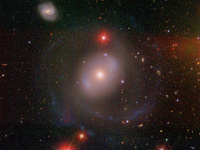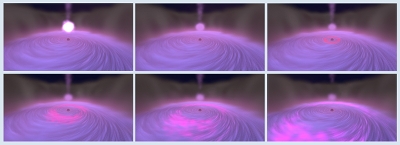XMM-Newton reveals light 'echo' around supermassive black hole
31 May 2012
Astronomers studying the galaxy NGC 4151 with ESA's XMM-Newton space observatory have detected X-rays emitted and then reflected by ionised iron atoms very close to the supermassive black hole hosted at the galaxy's core. By measuring the time delays occurring in these 'reverberation' events, they were able to map the vicinity of this black hole in unprecedented detail. |
| Galaxy NGC 4151. Credit: David W. Hogg, Michael R. Blanton, and the Sloan Digital Sky Survey Collaboration |
Supermassive black holes are enormous concentrations of matter, weighing millions to billions of times the mass of the Sun, that reside at the centre of most large galaxies, including the Milky Way. As they do not emit light, these extremely dense objects can only be detected indirectly, via the effect exerted by their intense gravitational pull on the neighbouring matter. A small fraction of these supermassive black holes feed on material from their surroundings at extraordinary rates, giving rise to intense emission that may even outshine the entire radiation output of their host galaxies. Known as Active Galactic Nuclei (AGN), these sources are a powerful tool used by astronomers to probe the dynamics of matter around the most massive of black holes.
The accretion of matter onto a black hole occurs through a disc of material that spirals around the black hole. Heated by internal friction up to millions of degrees, the accreting matter radiates profusely at ultraviolet and soft X-ray wavelengths. Astronomers invoke the presence of a corona located beyond the disc and populated by highly energetic electrons to explain the observed emission from AGN at hard X-ray wavelengths. Very little is known, though, about the shape and size of the corona, and about the origin of the electrons in the corona.
To investigate the extreme phenomena taking place in the near vicinity of black holes, astronomers studying AGN have been dedicating great efforts to detecting radiation from the innermost parts of the accretion disc and from the corona. An excellent diagnostic of both regions is to search for 'reverberation' – namely the light emitted by the corona and then reflected by the disc. Identifying reverberation events is possible because an AGN's emission is strongly variable, exhibiting flares and other fluctuations on very short time scales. If a burst of light in the corona were to induce excitation in the disc material, thus causing further emission from this region, then the two signals would be detected separated by a time delay. This delay contains valuable information about the path travelled by light from the corona to the disc, and astronomers have long tried to measure it to constrain the size and relative location of these two components.
| X-ray light 'echoes' around a black hole. (For further details click here.) Credit: NASA/Goddard Space Flight Center |
"We have now detected the first unequivocal evidence of time delay between emission from the corona and different parts of the disc in an AGN," says Abderahmen Zoghbi from the University of Maryland, USA. Zoghbi led a study of NGC 4151, a galaxy hosting one of the brightest AGN known at X-ray wavelengths, using data from ESA's XMM-Newton X-ray observatory. "The detection of a delay confirms that the corona is clearly separated from the disc, and the amount of delay – a couple of thousand seconds, about half an hour – indicates that it must be compact in size, and located very close to the black hole, above and below the central part of the disc," he adds.
The lag detected in this study was observed in a particular emission line that stands out in AGN spectra, the so-called iron K line. Produced by ionised iron atoms at an energy of about 6.4 keV, this line is one of the best understood features in the X-ray spectra of AGN. "Since we know the physics of the iron K line so well, our detection of delay in its signal is a direct proof of reverberation taking place very close to a supermassive black hole," comments Zoghbi. Previous detections of time delays in other AGN had relied on other, less well understood parts of the spectrum.
 |
| Reverberation of X-rays in the vicinity of a black hole. (For further details and an animated sequence click here.) Images and animation courtesy of Abderahmen Zoghbi, University of Maryland, USA |
"Perhaps most interestingly, not only did we detect a delay in the iron K line emission between corona and disc, we were also able to reveal the disc's progressive response," notes co-author Andrew Fabian from the Institute of Astronomy in Cambridge, UK. In fact, a detailed analysis of the line's distorted shape indicated that different delays affect the signal detected at different wavelengths. The most redshifted part of the line, which bears the strongest effects of the black hole's gravity and thus traces emission from the innermost part of the disc, displayed delays of a thousand seconds or less. Delays in the blueshifted part of the line, caused by emission from the outer disc, were significantly longer, up to 2000 seconds. "This allowed us to follow the 'echo' of the burst of light from the corona as it gradually illuminated the entire disc, making it shine at the wavelengths of the iron K line," Fabian adds.
Zoghbi and his collaborators are now repeating the same analysis on other AGN-hosting galaxies. Detecting reverberation-induced delays in a larger sample of sources will provide astronomers with a comprehensive dataset to study matter accretion onto black holes in unprecedented detail and, ultimately, to test general relativity in one of its strongest regimes.
"This study has finally uncovered a long-sought-after aspect of AGN that unambiguously reveals their innermost regions," comments Norbert Schartel, XMM-Newton Project Scientist at ESA. "Observations are now beginning to disclose what happens in the 'backyard' of a black hole, allowing us to sharpen our understanding of these fascinating objects."
Notes for editors
The findings presented here are based on several observations of the galaxy NGC 4151 performed with ESA's XMM-Newton space observatory at energies between 2 and 10 keV.
NGC 4151 is a well-studied Seyfert galaxy, hosting one of the brightest active galactic nuclei (AGN) known at X-ray wavelengths. The supermassive black hole lying at the centre of NGC 4151 has a mass of about 50 million solar masses.
The emission spectrum of an AGN in the X-ray band (divided into soft X-rays, between 100 eV and 10 keV, and hard X-rays, between 10 and 100 keV) is characterised by three main components: emission from the accretion disc, which dominates up to a few 100 eV; emission from Compton up-scattering of photons from the disc in the corona, which dominates up to a few tens of keV; reflection of high-energy photons from the corona off the disc material, resulting in hard X-ray emission that dominates the spectrum up to 100 keV or more.
Reflection off the disc also gives rise to fluorescence, or line emission from a number of heavy elements present in the disc. Among the several fluorescent lines in AGN spectra, the most prominent is the so-called iron K line, corresponding to an energy of 6.4 keV; this is a combined effect of the relatively large abundance of iron in the Universe and of the high efficiency of this particular emission process.
The iron K line has an intrinsically narrow profile. However, when the line arises from iron ions in the accretion disc around a black hole, its shape is affected by relativistic effects induced by the black hole's strong gravitational field. Thus, in an AGN spectrum, the iron K line appears distorted, broadened and shifted to slightly lower energies. With the aid of the general theory of relativity, it is possible to quantify the distortion that will affect the line emitted by an iron ion at a certain distance from a black hole of a given mass. Astronomers can use distortions observed in the iron K line's shape to probe the entire extent of a black hole's accretion disc. This crucial aspect was exploited in the study of NGC 4151.
Related publication
A. Zoghbi, et al., 'Relativistic iron K X-ray reverberation in NGC 4151', Monthly Notices of the Royal Astronomical Society, 422, 129–134. DOI: 10.1111/j.1365-2966.2012.20587.x
Contacts
Abderahmen Zoghbi
Department of Astronomy
University of Maryland, USA
Email: azoghbi astro.umd.edu
astro.umd.edu
Phone: +1-301-405-65-75
Andrew C. Fabian
Institute of Astronomy
Cambridge, UK
Email: acf ast.cam.ac.uk
ast.cam.ac.uk
Phone: +44-1223-337509
Norbert Schartel
ESA XMM-Newton Project Scientist
Directorate of Science and Robotic Exploration
European Space Agency
Email: Norbert.Schartel esa.int
esa.int
Phone: +34-91-8131-184



